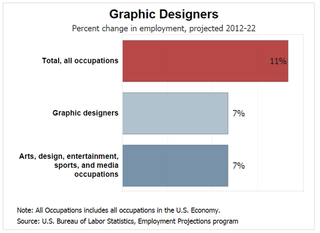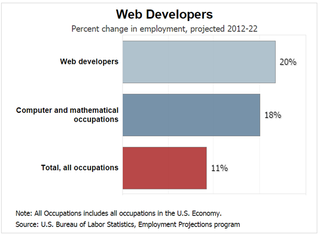The value of adding web skills to your armoury
A few extra skills can make a world of financial difference, as Lance Evans explains.
Let's face it, you probably didn't go into the graphic arts expecting to become rich and famous. But you still wanted to make a good living. For some that's been more difficult over the last few years. While for others, sitting just a cubicle away, it's actually gotten much easier.
The US Department of Labor's Bureau of Labor Statistics just came out with income stats and projections for various jobs in our industry (see graphic designers here and web developers here). It underscores what many of us have known to be true from first hand experience, that adding technical savvy to our skill set can significantly boost our value in the market. But before we jump into the numbers, let's start with some basics.
There are a lot of confusing and overlapping job titles in our field, like Art Director, Graphic Artist, Designer, Print Designer, Web Designer, all predominantly creative roles. By contrast, jobs like Internet Architect, Computer Programmer, Web Programmer and other variants, are jobs that generally include little or no creative work and instead involve a range of technology.
There is yet another job title, that of Web Developer. It's a bit unique in that it entails both creative and technology skills. The Department of Labor describes this job as:
"Web developers design and create websites. They are responsible for the look of the site. They are also responsible for the site's technical aspects", "They also may create content for the site.", "debug applications for a website" and "Write code for the site".
While I know there are some truly gifted souls who can design, create art, and program the entire back end of a corporate website... I haven't met too many of them. They are who every employer is looking for, an almost mythical person that can do it all.
This push towards technology has had a significant impact on creatives that once worked strictly in print. Those that could make the technological (and aesthetic) leap to web design have fared much better over the last decade than those that could not.
Get the Creative Bloq Newsletter
Daily design news, reviews, how-tos and more, as picked by the editors.
Making that jump
Aaron MacDonald is one that made that leap. As owner and creative director of A3 Creative Solutions, in Canada, he grew up in the printing industry and spent years as a freelancer print designer. But as the internet grew, he realized that was the market he needed in order to open the design shop he had wanted.
"A few years ago I was accepting jobs to do postcards and similar small projects. But today I'm much busier producing websites for a wide range of companies. It's a much better business, and the demand for my work is now much higher."
Aaron took his creative abilities to the web by first jumping onto Adobe Muse while it was still in early beta. "It allowed me to easily take my design work to the web. It made the transition easy for me. From there I moved on to producing sites in Dreamweaver mostly. Though I still use Muse to quickly knock out ideas for clients."
Taking control
Evan Seplow, based in midtown Manhattan, had a similar transition. "I had come from both a print and a video/film background. But no matter what media you're in today, it all ends up on the web. I realized that I had to know that medium in order to exist in the market, and get the kinds of projects I wanted."
Evan spent much of his free time over the last few years teaching himself Wordpress, PHP and HTML. The benefits to his marketability have been tremendous. "I'm able to get entire projects done for my clients now. And not sitting around waiting on a programmer to do things for me — hoping it looks the way I wanted it to. I'm much more in control of both my work, and career."
A Tale of Two Cities
The annual and hourly incomes listed in the new reports reflect the experiences Aaron and Evan describe. Based on data from 2012, the average Graphic Designer (i.e. a print designer) in the US made $44,150 per year, or $21.22 per hour. But the Web Developer sitting in the next cubicle was bringing in $62,500 per year, or $30.05 per hour. That's just shy of 50 per cent more income.
This Tale of Two Cities actually looks even more bleak when we read the report's 10 year projections from 2012 to 2022. Over that period the entire US job market is projected to increase by 11 per cent, whereas Graphic Designer jobs are headed for a very sluggish 7 per cent growth rate. That's over 36 per cent LESS GROWTH than the average. As you can see in the accompanying bar chart, similar arts and design positions are also faring just as poorly. It's interesting to note though, that the projection for Art Directors is dead-on average at 11 per cent growth.

By comparison, the outlook for Web Developers is fabulous, projected for a huge 20 per cent. That's just shy of twice the projected growth of the entire US job market. This isn't just because of the technology, as some tech markets are shrinking, like Computer Programmers are only expected to grow 8per cent.

More than likely the Web Developer's growth is more a factor of the Internet's continued expansion as a whole and the demand it will create, rather than just knowledge of technology in and of itself.
Where Do You Take It?
Obviously, learning development tools and programming is easier said than done, especially for creative types. But it's clear that the more you add to your skill set, the better you will be doing in the years to come. The positive take-away here is two fold. First is that web tools are continually getting easier to use. And the popularity of Wordpress, Adobe Muse, SquareSpace.com and other options is making things much easier.
The second thing to keep in mind is that this isn't an all or nothing proposition. Start learning one thing now, and then keep building on it. In 12-24 months you may very well be amazed at what you can do, and what you can earn.
Words: Lance Evans
Lance Evans is creative director of Graphlink Media.
Like this? Read these!
- The designer's guide to working from home
- Brilliant Wordpress tutorial selection
- Our favourite web fonts – and they don't cost a penny

Thank you for reading 5 articles this month* Join now for unlimited access
Enjoy your first month for just £1 / $1 / €1
*Read 5 free articles per month without a subscription

Join now for unlimited access
Try first month for just £1 / $1 / €1
The Creative Bloq team is made up of a group of design fans, and has changed and evolved since Creative Bloq began back in 2012. The current website team consists of eight full-time members of staff: Editor Georgia Coggan, Deputy Editor Rosie Hilder, Ecommerce Editor Beren Neale, Senior News Editor Daniel Piper, Editor, Digital Art and 3D Ian Dean, Tech Reviews Editor Erlingur Einarsson and Ecommerce Writer Beth Nicholls and Staff Writer Natalie Fear, as well as a roster of freelancers from around the world. The 3D World and ImagineFX magazine teams also pitch in, ensuring that content from 3D World and ImagineFX is represented on Creative Bloq.
